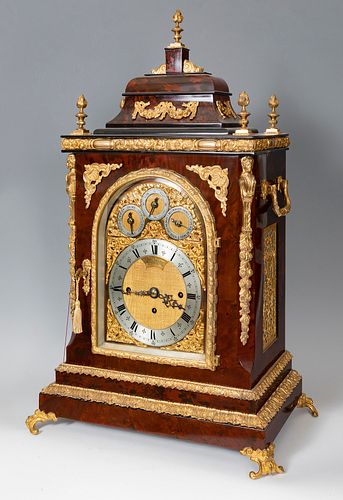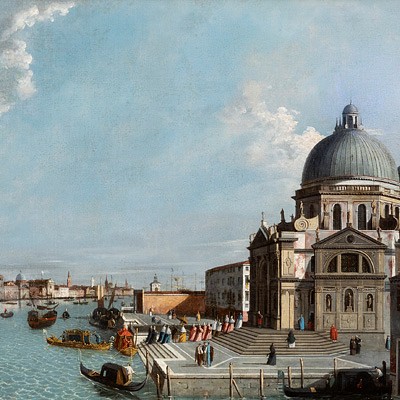Victorian mantel clock. London, ca.1820. Tortoiseshell and gilt bronze. It would chime in hours, a half and a quarter.
Lot 31
About Seller
Setdart Auction House
Carrer Aragó 346
Barcelona
Spain
Setdart Subastas was born in 2004 and is currently the first online art auction in Spain with solidity, prestige and reliability guaranteed by our more than 60,000 users. Setdart has a young, dynamic and enterprising team ready to successfully manage the purchase and sale of art works through custom...Read more
Categories
Estimate:
EUR€12,000 - EUR€14,000
$12,903.23 - $15,053.76
Absentee vs Live bid
Two ways to bid:
- Leave a max absentee bid and the platform will bid on your behalf up to your maximum bid during the live auction.
- Bid live during the auction and your bids will be submitted real-time to the auctioneer.
Bid Increments
| Price | Bid Increment |
|---|---|
| EUR€0 | EUR€10 |
| EUR€200 | EUR€25 |
| EUR€500 | EUR€50 |
| EUR€1,000 | EUR€100 |
| EUR€3,000 | EUR€200 |
| EUR€5,000 | EUR€500 |
| EUR€10,000 | EUR€1,000 |
| EUR€20,000 | EUR€2,000 |
| EUR€50,000 | EUR€5,000 |
About Auction
By Setdart Auction House
May 18, 2021
Set Reminder
2021-05-18 09:30:00
2021-05-18 09:30:00
America/New_York
Bidsquare
Bidsquare : Classics XIX and XX
https://www.bidsquare.com/auctions/setdart-auction-house/classics-xix-and-xx-6961
The next 18th May there will be a 19th and 20th Century Classics Auction at Setdart.com There will be a select repertoire of important artists such as Carlos Cruz Diez, Luis Feito, Joan Miró, Fernando Botero, Josep Llimona, Salvador Dalí among others. Setdart Auction House sofia@setdart.com
The next 18th May there will be a 19th and 20th Century Classics Auction at Setdart.com There will be a select repertoire of important artists such as Carlos Cruz Diez, Luis Feito, Joan Miró, Fernando Botero, Josep Llimona, Salvador Dalí among others. Setdart Auction House sofia@setdart.com
- Lot Description
Victorian mantel clock. London, ca.1820. Tortoiseshell and gilt bronze. It would chime in hours, a half and a quarter. Inscription on the dial: John SPENCER, London. Measurements: 73 x 49 x 32 cm. English bracket clock made in the early nineteenth century. Its case, of architectural structure, combines tortoiseshell with gilded bronze applications as ornamental motifs worked in relief. The flanks are decorated with stipes as female figures made in synthetic style between the Greek and Egyptian legacy. Also in bronze are the openwork lattices in the corners of the facade, in the tympanum and the floral festoons that cover the stepped talus-like dome, as well as the feet and the openwork compositions that decorate the flanks. The dial bears the signature of John Spencer and has Roman numerals engraved in black on silver plate. Three small dials accompany it, for chiming functions. Bracket watches of English origin stand out mainly for their mechanism, but also for their decoration. This typology has its origin in the decade of the 60's of the XVII century, when the pendulum was applied to the clock replacing the previous regulator of "foliot" or steering wheel. This change made it necessary to provide the mechanism with a case that would protect it from shocks that could alter its movement. Thus were born the watches known in England as brackets, i.e. transportable watches. These were short case pieces, which housed inside a mechanism held between two thick plates and containing, as a driving force for each train, a combination of hub and snail. These clocks were initially designed to be placed on a bracket, hence their English name. This bracket was an independent piece that was usually manufactured at the same time, with decoration to match the clock. Later, however, the base and clock began to be made separately. The English developed a watchmaking mechanics different from that of the rest of Europe, based on an industry of specialized workshops that produced products of great technical perfection. The cases were made by cabinetmakers who enriched the watches, turning them into real jewels. Therefore, throughout the eighteenth century English clocks will show the stylistic evolution that developed in English cabinetmaking, starting with the William and Mary and Queen Anne models, through the Chippendale style and the Hepplewithe to finally return to classicism with the Adam, the Sheraton and finally the Regency. Regarding the specific typology of the bracket clock, it maintained throughout the eighteenth century its elegant and stately appearance, and at the end of the century the cases will be larger, more monumental. The material used for their manufacture was usually, even in the 17th century, ebony or tortoiseshell, combined with bronze applications. From 1670, olive and walnut were also common, and later brass began to be used. From the 1720s onwards these woods were replaced by mahogany, more suited to the new taste. On the other hand, the dials used to have engraved figures on the front plate, or incorporated a silvered hour sector. Later, other elements would be added, such as the seconds hand, located on one side of the central arc, or the date, included in the dial. Even dials for the phases of the moon would be included.
- Shipping Info
-
In-House Shipping
-
- Buyer's Premium



 EUR
EUR CAD
CAD AUD
AUD GBP
GBP MXN
MXN HKD
HKD CNY
CNY MYR
MYR SEK
SEK SGD
SGD CHF
CHF THB
THB














